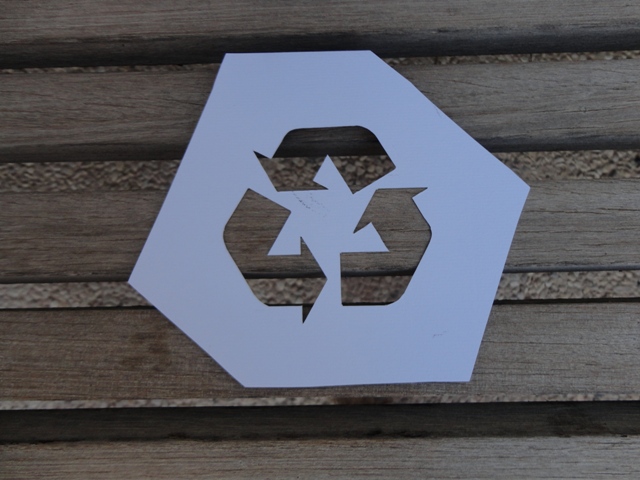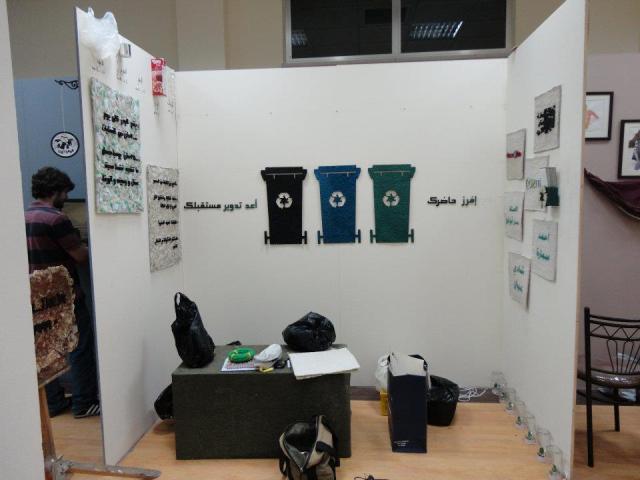My lovely cousin Basma Batayneh graduated last month from The University of Jordan with a Bachelor of Fine Arts degree. As part of her last year in uni, Basma had to work on an individual graduation project (the art degree's equivalent to a dissertation) that demonstrates the artistic skills that she has acquired over the past four years of her Fine Arts education. Basma decided that she wanted to use her skills creatively and not only have a project that showcased art, but a project that had a strong message behind it and that shed light and spread awareness on an issue that she felt passionately about. Thus, her graduation project focussed around the issues and reality of waste management in Jordan. Another important aspect of Basma's project was also using art to demonstrate the importance and benefits of recycling. All the art that was used was hand-made by her using 100% recycled materials!
A couple of weeks ago, I sat down for an interview with Basma, to ask her about waste management and recycling in Jordan, and to also find out about the techniques that went into producing the amazing project. Part 1 of the interview was all about waste management in Jordan, along with pictures of her visit to one of the landfills of the country. Today's post, Part 2, will be about the artistic aspect of the project, focussing on the process of basically turning waste into art... Enjoy!
 |
| Basma with her beloved hand-made green recycling bin! |
 |
| Basma and I surrounded by her recycled art. |
What was the artistic
aspect of the project about and why did you choose it?
Recycling, and how I was able to make different mediums from
100% recycled materials and how from a very simple idea, I was able to do
something unique and interesting that I can use in several ways. When my
professors first told us that we should start thinking about our graduation
projects, I went home and I noticed that I had a lot of waste and clutter
around the house, such as newspapers, old magazines and cardboard. So instead
of throwing them away, I thought to myself why not recycle them and do
something creative out of them. That’s how the idea started from there and I
kept experimenting till I was able to produce something that I was able to use
creatively to fulfil my vision.
Explain the
techniques that went into producing this project.
In school, during art class, we used to always make our own
papers using our own garbage, so waste such as paper and cardboard. We would
cut them up into small pieces and mix them with water and vinegar. We then used
to form a layer of it onto a net and flip it over and keep it to dry overnight,
so that the next day we were able to use it as actual paper that can be cut and
manipulated (draw on it or stick anything on it.). So I remembered this
technique when thinking of this project, and so I recreated this using
newspapers, cardboard and vinegar. For the big pieces that I made, I designed
my own net with a frame and I would leave the paper outside to dry till the
next day before I would flip it and get the final product. For the smaller ones, I
would cut the paper into tiny little pieces instead. I would soak it in water
till the consistency became dough-like and then I would add a bit of vinegar
and repeat the whole process as with the bigger pieces using the net.
For the pieces with logos and writings, after uploading the
logos and designs to illustrator, I would go to my friend who has a router for
laser cutting and we would cut the logos and letters precisely, and from there
I would colour them using eco-friendly paint.
 |
| The process of creating the recycled posters begins with mixing newspaper pieces and vinegar. |
 |
| The mixture is ready to use when its consistency become pasty. |
 |
| The paste is then placed on a framed net. |
 |
| After the paste is spread onto the net, it then needs to dry overnight. |
 |
| Once dry, the paste is turned into a poster! |
 |
| The poster is then topped with small newspaper pieces for texture purposes, and then the laser-cut words are added. |
 |
| The final result after the words are painted. |
How much time did the
entire project take from start to finish?
It took me about 3 months. At first I went out to Greater
Amman Municipality (GAM) and then I went to the landfill to film and get some
interviews and talk with some sponsors. But for the art pieces, it actually didn’t
take me much time. The most time consuming part was actually waiting for
everything to dry overnight. But once everything was dry, it was just a matter
of painting and putting things together. It all really is simple to make; it
just needs creativity and patience.
 |
| Basma reused Nescafé jars as small lamps for her presentation by painting the lids white and assign green light bulbs to them. |
 |
You have three art pieces
dedicated to Cozmo, GAM & Green Eve. Why?
GAM: because they are in charge of waste management in
Amman. I went with the people in charge to the site and saw how they manage the
waste, and in general they were very helpful with providing me with relevant
information and allowing me to interview them.
Cozmo (a large supermarket chain in Amman): because they
have recently become very active in spreading awareness about the importance of
recycling. They have established the first every recycling centre in Amman, in
their very own parking lot outdoors. People now get their garbage separated and
place them in the relevant recycling bins. They even have a bin dedicated to
bread and leftover food that they recycle into fodder for animals.
Green Eve: obviously because it is a Jordanian-related blog
that also promotes recycling and green initiatives, and I appreciate all that
it stands for.
 |
| From left to right: Cozmo, GAM and Green Eve. |
 |
| Basma's beautiful hand-made and 100% recycled Green Eve logo. Words cannot express how much I love this! |
 |
| The GE heart. |
 |
| GE logo comes to life with eco-friendly paint! |
Talk to us
about the feedback that you got for your project from your fellow students and
professors.
The other students in my course loved it and found it very
interesting. Many were surprised by the facts concerning waste management in
Jordan; they were especially interested in learning about the Al-Ghabawi
landfill. The exhibition was for two days, and I actually had three small bins
set out, similar to the ones used to encourage recycling in Umm Uthaina by GAM.
I knew that throughout the exhibition a lot of waste will pile up, so I was
thrilled to see the bins fill up, appropriately, with litter by visitors or
other students and professors.
My professors were very happy with the project and they were glad
to see that for the first time since 2002 (when the faculty was set up), a
student did a unique project about recycled art that was never done before!
 |
| Basma's mini gallery before. |
 |
| The mini gallery after! |
 |
| Presentation time!! |
Anoud x
ALL IMAGES BELONG TO GREEN EVE/ANOUD AL-FAWWAZ AND BASMA BATAYNEH.



2 comments:
I LOVE this post! What a great project Basma!! She managed to make it so interesting and captivating, mashallah. And I LOVE the Green Eve logo, I really want one in my room! Beautiful.
Love,
Alyazia xxxxxxx
Dears
We at Jordan GBC is launching a waste management project and looking for young interested people to join in as a champions in our coming campaign.
would you please contact me by mail sajeda@jordangbc.org and if it would be possible to have Ms. Basma Batayneh contact number/ E-mail
thank you
Post a Comment